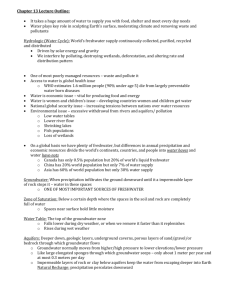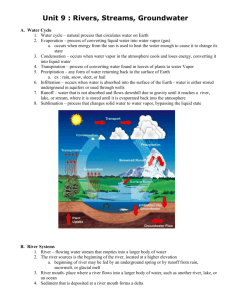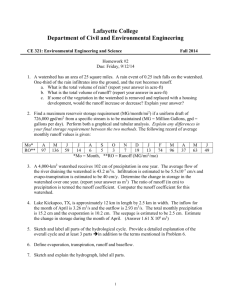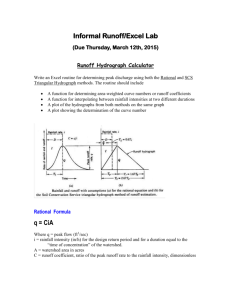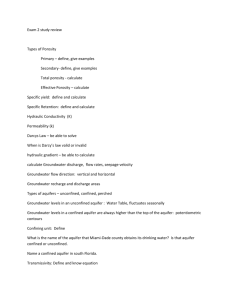Envirothon: Aquatic Ecology
advertisement
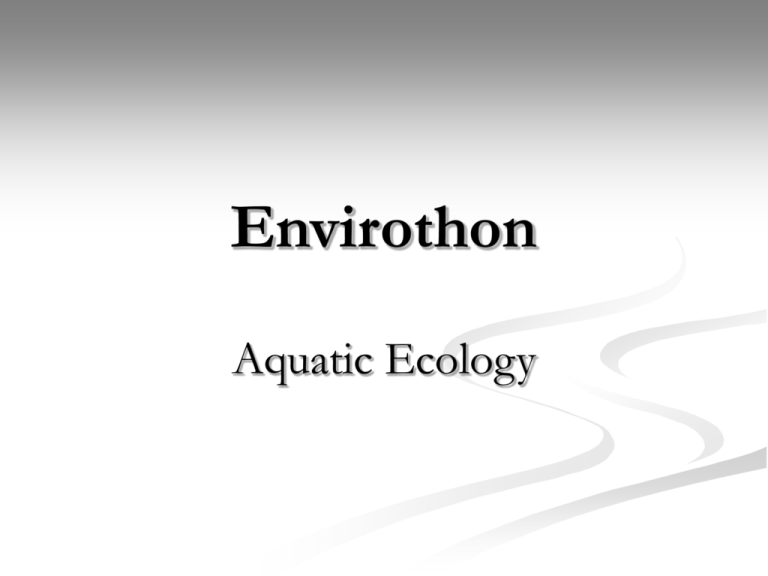
Envirothon Aquatic Ecology Identify the process and phases for each part of the water cycle Water Cycle terms [ ] Condensation [ ] Evaporation [ ] Evapotranspiration [ ] Freshwater storage [ ] Ground-water discharge [ ] Ground-water storage [ ] Infiltration [ ] Precipitation [ ] Snowmelt runoff to streams [ ] Spring [ ] Stream flow [ ] Sublimation [ ] Surface runoff [ ] Water storage in the atmosphere [ ] Water storage in ice and snow [ ] Water storage in oceans Natural Ground Cover 40% Evapotranspiration 10% Runoff 25% Shallow infiltration 25% Deep infiltration Infiltration Source: U.S. EPA References for Water Cycle Good source for diagrams, terms, and extensive discussion of all the water cycle components. Also simple methods for demonstrating sublimation and transpiration: http://ga.water.usgs.gov/edu/watercyclesummary.html#oceans Interesting, animated interactive water cycle: www.mrhall.org/science/epawatercycle/epawatercycle.htm Water cycle activities, 9th grade and lower: www.fi.edu/guide/bond/watercycleact.html Basic concept of water cycle with a section on human impacts: www.purdue.edu/dp/envirosoft/groundwater/src/cycle.htm Properties of water chemical properties A water molecule contains one atom of oxygen bound to two atoms of hydrogen. The hydrogen atoms are "attached" to one side of the oxygen atom, resulting in a water molecule having a positive charge on the side where the hydrogen atoms are and a negative charge on the other side, where the oxygen atom is. Since opposite electrical charges attract, water molecules tend to attract each other, making water kind of "sticky." (If the water molecule here looks familiar, remember that everyone's favorite mouse is mostly water, too). Properties of water chemical properties As the right-side diagram shows, the side with the hydrogen atoms (positive charge) attracts the oxygen side (negative charge) of a different water molecule. All these water molecules attracting each other mean they tend to clump together. This is why water drops are, in fact, drops! Properties of water physical properties Water is unique in that it is the only natural substance that is found in all three states -liquid, solid (ice), and gas (steam) -- at the temperatures normally found on Earth. Properties of water physical properties Water freezes at 32 Fahrenheit (F) and boils at 212 F. water's freezing and boiling points are the baseline with which temperature is measured: 0 on the Celsius scale is water's freezing point, and 100 is water's boiling point. Weight: 62.416 pounds per cubic foot at 32°F Weight: 61.998 pounds per cubic foot at 100°F Weight: 8.33 pounds/gallon, 0.036 pounds/cubic inch Density: 1 gram per cubic centimeter (cc) at 39.2°F, Fresh water ecosystems – important properties of water Ice is water in its solid form. Unlike most substances, which are densest in their solid state, ice is less dense than water and thus floats. If this were not the case, Fresh water lakes and rivers would freeze from the bottom up. Fish could not survive, and it is unlikely that rivers and lakes in northern countries would ever completely thaw. Saltwater ecosystems – important properties of water The oceans have a profound influence on climate. They are the world's great heat reservoirs and heat exchangers. Water has a high specific heat index. The high specific heat index of water also helps regulate the rate at which air changes temperature, which is why the temperature change between seasons is gradual rather than sudden, especially near the oceans. References for properties of water http://ga.water.usgs.gov/edu/waterproperties.html http://www.ec.gc.ca/WATER/en/nature/prop/e_therm.htm Analyze the interaction of competing uses of water for water supply, hydropower, navigation, wildlife, recreation, waste assimilation, irrigation, industry and others. uses of water supply, hydropower, navigation, wildlife, recreation, waste assimilation, irrigation, industry, and others United States Geological Service (USGS) surveys nation wide water use every 5 years. The chart to the right is based on the 2000 survey. Water Users -References http://ga.water.usgs.gov/edu/wateruse.html Estimated use of Water in the United States in 2000: http://ga.water.usgs.gov/edu/wateruse2000.html Discuss methods of conserving water and reducing point and nonpoint source pollution Water Conservation: The City of Richardson website is a good source of information. The supplier of water to Richardson, The North Texas Municipal Water District, also has an informative website. Discuss methods for reducing point and non-point source pollution Discuss methods for reducing point and non-point source pollution Point sources: A point source is a readily identifiable source. A typical example is a pipe leading from an industry directly to a river. The pipe is easily identified and can be traced back to the industry. Some examples of point sources are industrial plants, wastewater treatment facilities, landfills, restaurants, etc. Most point sources have already been identified and are highly regulated. Water Conservation References City of Richardson, Texas http://www.cor.net/news/waterconservation.htm North Texas Municipal Water District: http://www.ntmwd.com/droughtInfo.html Hydrograph of water level in Jim Chapman Lake: http://ahps.srh.noaa.gov/hydrograph.php?wfo=fwd&gage=sclt2&view=1,1, 1,1,1,1 Hydrograph of water level in Lake Lavon: http://ahps.srh.noaa.gov/ahps2/hydrograph.php?wfo=fwd&gage=lvnt2&gr oup=255084&view=1,1,1,1,1,1 Water Conservation: Off the Subject The majority of the water used in the urban Dallas-Fort Worth area comes from lakes (surface water). The water sources for Richardson are Lake Chapman and Lake Lavon. Included in the references are water level graphs from both Lake Chapman and Lake Lavon. The water levels can be tracked and hypothetical volumes of water used, and more importantly how much water is left, could be calculated. This exercise underscores how serious drought conditions are in North Texas and can be used to further discussion on conservation. Explain the different types of aquifers and how each type relates to water quantity and quality Aquifers - unconfined Groundwater below a layer of solid rock or clay is said to be in a confined aquifer. The rock or clay is called a confining layer. A well that goes through a confining layer is known as an artesian well. The groundwater in confined aquifers is usually under pressure. This pressure causes water in an artesian well to rise above the aquifer level. Aquifers - Unconfined Water percolates through the soil until the soil is saturated. The top of the saturated zone is called the water table. The water table rises and falls according to the season and the amount of rain that has occurred. Note that bedrock below the saturated zone prevents the water from penetrating more deeply. An unconfined aquifer lacks a confining layer on the top of the saturated zone. http://groundwater.orst.edu/under/aquifer.html#Confined Aquifers Confined aquifer Unconfined aquifer Slow to recharge; recharge time may be in years or decades Quick to recharge; recharge time may be in months or even days Less susceptible to pollution More susceptible to pollution Quantities of water generally lower than confined aquifers Quantity of water greater than unconfined Aquifers Unconfined aquifer aquifers Ground Water Protection Identify common aquatic organisms through the use of a key Using a Key: All keys are based on distinguishing characteristics The size or shape of head, thorax, or abdomen can be a distinguishing characteristics What Is a Watershed? A watershed is the area of land that drains to a particular point along a stream Center for Watershed Protection Watershed delineation references City of Richardson, Texas: http://www.cor.net/ Maps and various publications on water resources in the Trinity River Basin: http://tx.usgs.gov/trin/pubs Describe changes to the aquatic ecosystem based on alteration to the aquatic habitat From Lane, 1955 Impervious Cover and Storm water Runoff 100% Precipitation over Watershed Natural Developed Evaporation Surface Runoff Groundwater 40% 10% 50% 25% 50% 30% Source: U.S. EPA and Center for Watershed Protection “Site Planning for Urban Stream Protection”, Dec 1995 Impervious Cover and Storm water Runoff Surface Runoff Generated from a One-Inch Rainstorm One-Acre Open Meadow - 218 cubic feet One-Acre Paved Parking Lot - 3,460 cubic feet Source: U.S. EPA and Center for Watershed Protection “Site Planning for Urban Stream Protection”, Dec 1995 Wetlands Far from being useless, disease- ridden places, wetlands provide values that no other ecosystem can, including natural water quality improvement, flood protection, shoreline erosion control, opportunities for recreation and aesthetic appreciation, and natural products for our use at no cost. Wetlands can provide one or more of these functions. Protecting wetlands in turn can protect our safety and welfare. www.epa.gov/owow/wetlands/vital/people.html Natural Water Quality Improvement Wetlands have important filtering capabilities for intercepting surface- water runoff from higher dry land before the runoff reaches open water. As the runoff water passes through, the wetlands retain excess nutrients and some pollutants, and reduce sediment that would clog waterways and affect fish and amphibian egg development. Bolivar Flats, Texas Wetlands provide flood protection Wetlands function as natural sponges that trap and slowly release surface water, rain, snowmelt, groundwater and flood waters. Trees, root mats, and other wetland vegetation also slow the speed of flood waters and distribute them more slowly over the floodplain. This combined water storage and braking action lowers flood heights and reduces erosion. Riparian = Edge of Water Riparian Habitat: Areas adjacent to rivers and streams with a differing density, diversity, and productivity of plant and animal species relative to nearby uplands. REFERENCES American Rivers, Natural Resources Defense Council and Smart Growth America, 2002, Paving Our Way to Water Shortages: How Sprawl Aggravates the Effects of Drought Center for Watershed Protection, October 1998, Rapid Watershed Planning Handbook: A Comprehensive Guide for Managing Urbanizing Watersheds Center for Watershed Protection, December 1995, Site Planning for Urban Stream Protection North Carolina Stream Restoration Institute and North Carolina Sea Grant, Stream Restoration: A Natural Channel Design Handbook North Central Texas Council of Governments, www.dfwinfo.com/forecast University of Virginia, July 2002, A Stream Corridor Protection Strategy for Local Governments, http://www.virginia.edu/~envneg/IEN_home/htm. US Department of Agriculture/Soil Conservation Service, Agricultural Handbook 296, USGPO, Washington, D.C. US Department of Agriculture/Soil Conservation Service, 1981, Land Resource Regions and Major Land Resource Areas of the United States, USGPO, Washington, D.C. US Department of Agriculture/Soil Conservation Service, National Resources Inventory, www.usda/nrcs.gov/technical/NRI U.S. EPA, 2005, Protecting Water Resources with Smart Growth, Publication EPA 231-R-04-002, www.smartgrowth.org Water Quality Assessment Biological: bacteria, algae, aquatic insects, fish, vegetation Physical: temperature, turbidity and clarity, color, salinity, suspended solids, dissolved solids, flow, Chemical: pH, dissolved oxygen, biological oxygen demand, nutrients (including nitrogen and phosphorus), organic and inorganic compounds (including toxics) Aesthetic: odors, taints, color, floating matter Biological Assessment Many types of bacteria are found in natural waters. For the most part bacteria are beneficial; breaking down organic material and thus releasing nutrients back into the water. Nutrients that are then used for growth of algae and plants. Other bacteria in water, when found in large numbers, may cause illness and death in people and animals. These bacteria are known as pathogens. The source of these pathogens is typically human and animal feces entering the waterways through direct discharge or indirectly from surface runoff. Testing of bacteria is routinely performed on many waterways; but it is time consuming and fairly expensive. Biological Assessment Many types of insects live part of their life cycles in water. Aquatic insects are often sensitive to pollutants in water. This tolerance of different organisms to water pollution has been measured. This information can be used to indirectly assess water quality. By sampling the water, the presence or absence of different organisms can be quantified. Conclusions about the water quality can be drawn from this information. Biological Assessment Fish, worms, mollusks, and arthropods are other organisms that are often sensitive to pollutants in water. Assessments of water quality can be made by sampling these organisms and noting their relative presence or absence. Physical Assessment The physical characteristics of the watershed, flood plain, and riparian area greatly influence water quality and the quality and quantity of available habitat for organisms. Extremes of water temperature are moderated by the amount and type of vegetation in the riparian areas (shading) The amount of turbidity, suspended solids, dissolved solids directly relates to soils present in the watershed, also to the amount of soil disturbance. Chemical Assessment pH range in most inland water is 6-9 standard units. Chemical Assessment The amount of dissolved oxygen is critical to most aquatic organisms. Photosynthesis is the primary source of oxygen in most waters. wind-driven wave aeration and aeration by falling water can also be significant. Chemical Assessment Nitrogen Cycle http://www.marietta.edu/~biol/102/ecosystem.html Chemical Assessment Phosphorus http://www.marietta.edu/~biol/102/ecosystem.html Water Assessment Resources Good source of information on fish identification and related activities: http://www.spart5.k12.sc.us/techtraining/teacher/web pages/SCFish/sc_fish_activities.htm Information on different nutrient and gas cycles: http://www.marietta.edu/~biol/102/ecosystem.html Water Protection and Regulation Clean Water Act Safe Drinking Water Act Wellhead Protection Underground Injection Control Sole Source Aquifer www.purdue.edu/dp/envirosoft/groundwater/src/epa.htm
